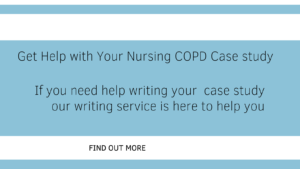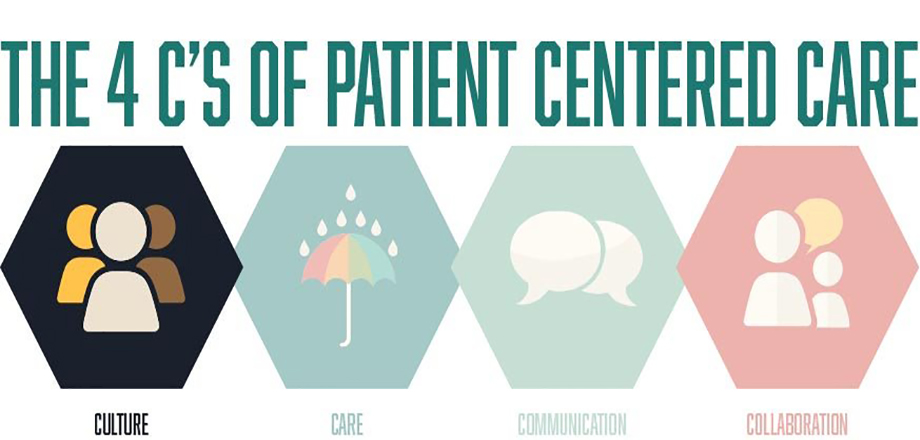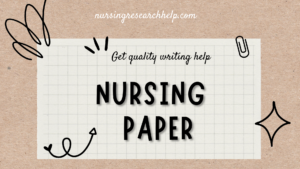COPD case study help-NUR104 Task 3 Case study:
COPD Case Study –NUR104 Task 3 Case study:
Are you looking for an honest and reliable online writing service for COPD case study help. Well, you have come to the right place. We are one of the best online nursing essay writing companies, offering excellent writing experience for all your nursing assignments.
Pathophysiology Of COPD
Chronic obstructive pulmonary disease (COPD) is a chronic respiratory disease that occurs due to increased inflammation in the airways of the lungs. As the airways become inflamed, they can narrow and damage the parenchyma. The condition can lead to exacerbations and other complications. COPD is a complex and challenging disease, but the right treatment can lead to improved health and quality of life.
Acute exacerbations of COPD can occur in a variety of settings, and the pathophysiology of these events is not fully understood. However, they can be triggered by exposure to irritants, infections, and certain medications. They can also result in lung damage and further complications. Fortunately, the diagnosis and management of acute COPD exacerbations have improved over the years.
Although a simple, accurate test for diagnosis of a COPD exacerbation is still undeveloped, recent studies have provided a better understanding of the clinical presentation and pathophysiology of acute exacerbations. Recent practice guidelines have recognized that prompt recognition of an acute exacerbation is essential, and that all exacerbations should be treated as quickly as possible.
In addition to causing airflow limitation, systemic inflammation and oxidative stress may play a role in airflow limitation. Oxidative stress is caused by an imbalance between oxidants and antioxidants. It can lead to inflammation and protease/anti-protease imbalances. These conditions contribute to the structural damage and impair the ability of the respiratory muscle to clear mucus from the lungs. Ultimately, oxidative stress can also increase lipid peroxide levels in the skeletal muscle.
In addition to inflammation, oxidative stress can also lead to tissue damage from inflammatory cell infiltration. Studies have found that plasma fibrinogen and tumour necrosis factor-alpha both correlate with an increased risk for hospitalization for COPD.
In addition to the inflammatory and oxidative components of the disease, structural changes can also contribute to airflow limitation. These include changes in the size and shape of the airways, loss of parenchymal tethers, and decreased elasticity of the small airways. Eventually, emphysema develops, resulting from the formation of more air spaces in the lungs.
Exacerbations of COPD can occur as an isolated event or in conjunction with an ongoing respiratory infection, which is a contributing factor to airflow limitation. Other etiologies, such as exposure to cigarette smoke, can also cause acute exacerbations.
During an exacerbation, the oxygen levels in the lungs are depleted. This can result in a high blood pressure in the blood vessels surrounding the lungs. Often, the severity of an exacerbation depends on its location and the degree of neuromechanical dissociation. Severe, or critical, exacerbations tend to be associated with a dramatic decrease in the amount of air that can be exhaled in one second. Moderate exacerbations can share similar basic physiological underpinnings to severe exacerbations, but are likely to be more stable in nature.

Symptoms, Diagnosis, and Treatment of COP
Symptoms of COPD may vary a great deal from patient to patient, and a proper diagnosis should be made with the use of a detailed clinical history and a pulmonary function test. Lifestyle changes and non-pharmacological therapies are important in the treatment of patients with COPD. Additionally, combination therapy can be used to increase bronchodilation and reduce the frequency of exacerbations.
COPD, or Chronic Obstructive Pulmonary Disease, is a respiratory disorder that affects millions of Americans. This disease has a variety of causes and effects and can cause severe illness. Here are some of the symptoms, diagnosis, and treatment options. The article also discusses the psychological and social implications of the disease and the ways in which it can be prevented.
Symptoms
If you have COPD, you have a variety of symptoms that can affect your daily life. These symptoms may include shortness of breath, coughing, and chest congestion. The condition can be controlled with treatment and can improve your quality of life.
Chronic obstructive pulmonary disease (COPD) is a long-term condition that involves the airways in your lungs. It can be caused by smoking, exposure to air pollution, or a medical condition.
Symptoms of COPD usually worsen over time. People with the disease are also more likely to have exacerbations, or sudden flare-ups of symptoms.
A spirometry test can be used to detect COPD before it causes symptoms. This test measures the size of your lungs, how well they breathe, and how much oxygen your lungs can move into your blood.
Treatment options
Chronic obstructive pulmonary disease (COPD) is a respiratory disorder characterized by chronic airflow limitation and breathlessness. This condition affects millions of people worldwide, mainly due to smoking. As such, it is one of the leading causes of premature death.
For patients with COPD, it is important to find ways to reduce symptoms and improve quality of life. One way is to improve oxygenation. This is accomplished by using nasal prongs to deliver oxygen.
Another approach is to get a better handle on your asthma. Your doctor can recommend ways to help you avoid lung irritants, such as secondhand smoke. He may also suggest supplements and nutritional products. You may even need to get a pneumonia, influenza, or coronavirus vaccine.
The most effective way to combat the effects of COPD is to stop smoking. If you are unable to do this, your doctor will likely prescribe medications that help you quit.
Psychological wellbeing of the sufferer
Chronic obstructive pulmonary disease (COPD) is one of the most common chronic diseases. It is characterized by chronic airflow obstruction that results in poor quality of life and a high rate of hospitalisation. Aside from the physical burden, patients with COPD also face a variety of psychological challenges.
Depression and anxiety are common in COPD patients. Several studies have investigated the relationship between depression and pulmonary symptoms, as well as the impact of COPD symptoms on depression. These studies show that patients with depression experience more shortness of breath, fatigue, and anxiety. Moreover, depression has been associated with more COPD symptoms, and patients with depression often experience a higher risk of exacerbations.
Managing emotional health is crucial to improve both the physical and mental health of COPD patients. Research has shown that anxiety and depression can be treated with psychological interventions. If identified early, patients can be more likely to receive adequate treatment.

NUR104 Task 3 Case study sample:
Roy Campesie is 78 years of age and lives in Caloundra , in South East Queensland. He lives in a three bedroom apartment and is the primary caregiver for his partner of 45 years Jim who is 84 years of age and is partially paralysed after a stroke three years ago. Jim needs help transferring from his bed to a chair and needs a wheelchair to get around the apartment.
Roy helps Jim dress but Jim is fiercely independent when it comes to his personal care. Roy has to be very diplomatic to ensure Jim has regular showers and attends to his personal hygiene. After Jim’s stroke community nurses were arranged to help them get settled once Jim was discharged home, and they come by each month now to see how they are getting on.
Roy still has the occasional cigarette to relax and de-stress, despite a long standing diagnosis of mild chronic obstructive pulmonary disease (COPD) for which he has taken a corticosteroid puffer every morning for many years.
He says he enjoys reasonable health but has been having difficulty recently using the stairs to reach his second floor apartment, and is occasionally breathless on his daily walks pushing partner Jim along the Caloundra coastal walk. He carries a Ventolin puffer with him when he’s out and about, and finds he has been needing to use it more frequently. Fortunately for Roy and Jim their apartment has a lift.
Roy and Jim both enjoy sunbathing on their balcony when the weather is cooler, but Roy has noticed that his own skin is getting quite dry and he is bruising very easily. Dark blotchy areas of bruising can be seen on his forearms. Although Roy makes sure as advised by his GP to use non-perfumed moisturiser to ensure Jim’s skin integrity after showering, he has been struggling to find the time for his own skin care regime.
Roy’s GP recently increased his hypertension medication as his blood pressure has been higher than it should be for quite a few months, but Roy forgot to mention his increasing breathlessness. Their GP also announced that she was moving to Victoria and Roy is anxious about finding another gay friendly GP who they will feel comfortable with. They both express great anxiety about ever needing to go into an aged care facility fearing they would experience discrimination.
Roy and Jim used to both enjoy volunteering at their local St Vincent’s de Paul opportunity shop, but since Jim’s stroke have found that this was no longer possible. Roy feels he has a full time job looking after Jim now but really misses the social interaction that they enjoyed with the Vinnies team.
Raylene, Jim’s 57 year old daughter lives in Brisbane and comes up to see them both about once each month. She says she has noticed that Jim is not as sharp as he used to be and has had trouble remembering the names of some everyday items.
Roy is estranged from his children and hasn’t seen them for over 20 years. Roy still drives but recently caused a minor accident when he failed to see a car coming up on his right as he was leaving the car park, and pulled out in front of them. He says he was distracted by worrying about what Raylene had said about Jim’s deteriorating memory.
This morning Roy and Jim were out on their walk when Roy suddenly felt breathless again and needed to rest on a bench. When he tried to get up, he felt dizzy, lost his balance and ended up falling back on the metal rail of the bench tearing the skin on his left forearm.
Jim says Roy briefly passed out on the bench, but Roy says he was just dehydrated. After a little while Roy felt better, and using a napkin he had in his bag, wrapped up his wound and pushed Jim back to the apartment. Once they reached home, Roy noticed that his forearm was still bleeding a little and a large area of skin seemed to have peeled off and was hanging loosely from the tear.
Luckily it was the day the community nurse (in this case you!) was scheduled to visit.
Roy and Jim are well known to the community nurses. You are worried about Roy’s fall today and know you must conduct a full assessment. You also notice that the apartment is a lot more cluttered and messier than usual and Jim appears not to have washed for some time.
Hire our case study services to help you with COPD case study
Are you looking to get this case study answer to guide you when writing your essay? Contact us and get a sample case study at a very affordable rate.
Also if you need your work written from scratch, head over to our order form and place your order. Once you place your order, we will choose a writer who is very fit to write your case study. Then you can make your payment using our secure payment methods.
After you tell us when you need your paper, we will embark on a journey to provide the best case study, fully customised according to your instructions, well written without plagiarism, and delivered on time.
We understand the need to write a good paper, and we understand that you as our client deserves the best and score better in class. That is why we give you a proise of quality work even when you need your paper written urgently. Contact us now and let us help you.




























